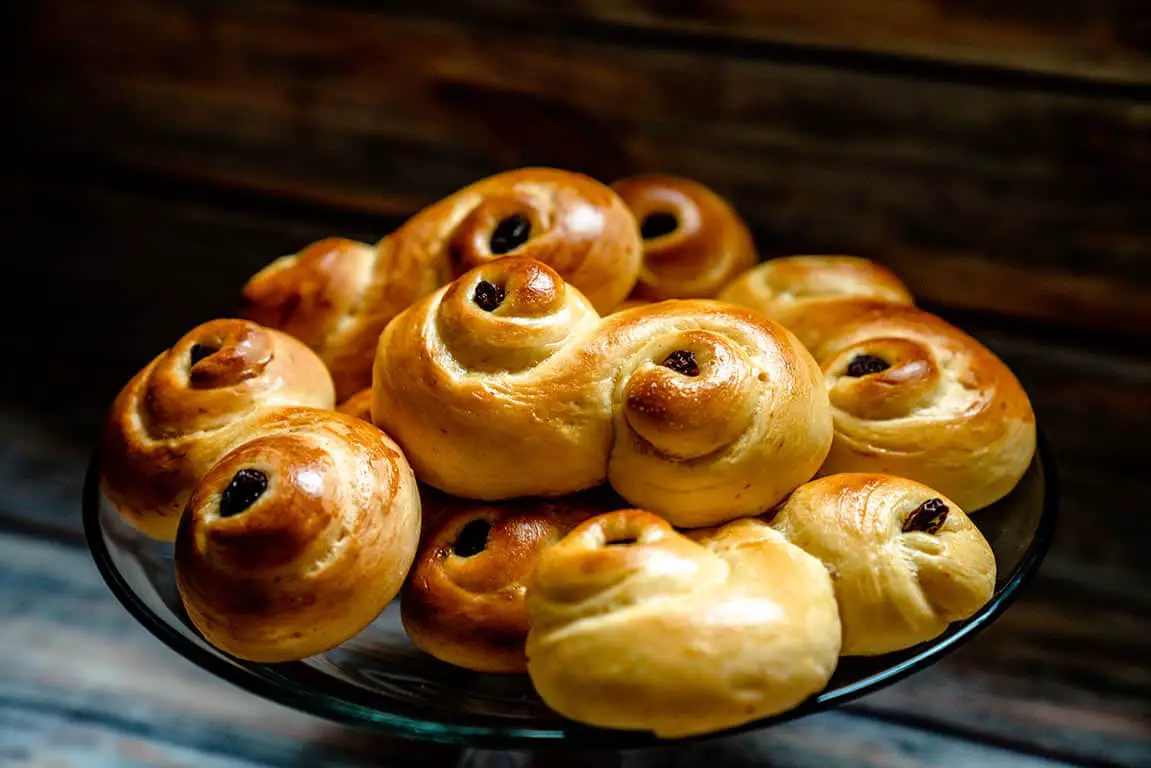Introduction :
Ingredients:
- 200ml milk
- 1/2 teaspoon saffron threads
- 100g unsalted butter
- 75g granulated sugar
- 1/2 teaspoon salt
- 7g (1 packet) active dry yeast
- 450g all-purpose flour
- 1 egg, beaten (for egg wash)
- Raisins or pearl sugar (for decoration)
Directions:
- In a small saucepan, heat the milk over low heat until warm but not boiling. Add the saffron threads and let steep for 10-15 minutes.
- In a large mixing bowl, cream together the butter, sugar, and salt until light and fluffy.
- Add the saffron-infused milk to the butter mixture and stir to combine.
- Sprinkle the yeast over the mixture and let it sit for 5-10 minutes until foamy.
- Gradually add the flour to the mixture, stirring until a dough forms.
- Knead the dough on a floured surface for 5-7 minutes until smooth and elastic.
- Place the dough in a greased bowl, cover with a clean kitchen towel, and let it rise in a warm place for 1-2 hours or until doubled in size.
- Punch down the dough and divide it into equal portions. Shape each portion into a bun or desired shape.
- Place the buns on a baking sheet lined with parchment paper, cover with a kitchen towel, and let them rise for another 30-45 minutes.
- Preheat the oven to 200°C (400°F). Brush the risen buns with beaten egg and decorate with raisins or pearl sugar.
- Bake in the preheated oven for 12-15 minutes or until golden brown.
- Remove from the oven and let the buns cool on a wire rack before serving.
Expert Tips for Serving and Storage:
- Serve Swedish saffron buns warm with a cup of coffee or tea for a cozy treat.
- Store any leftover buns in an airtight container at room temperature for up to 2 days. Refresh them by briefly heating in the oven before serving.
Nutritional and Health Benefits:
- Saffron contains antioxidants and may have anti-inflammatory properties.
- Consuming saffron in moderation may promote mood regulation and support overall well-being.
Variations to Explore:
- Add chopped almonds or candied citrus peel to the dough for extra flavor and texture.
- Substitute part of the flour with whole wheat flour for a heartier bun.
- Experiment with different shapes, such as braids or knots, for a unique presentation.
Conclusion:
Indulge in the aromatic and flavorful delight of Swedish saffron buns, a beloved treat enjoyed during festive occasions and everyday moments alike. With their golden hue and delicate saffron-infused flavor, these buns are sure to brighten any table and bring joy to all who partake in their goodness.
Frequently Asked Questions:
- Can I use instant yeast instead of active dry yeast? Yes, you can typically substitute instant yeast for active dry yeast in equal amounts. However, since instant yeast does not require proofing, you can mix it directly with the dry ingredients instead of proofing it in warm liquid.
- Can I substitute milk with a dairy-free alternative? Yes, you can use dairy-free milk alternatives such as almond milk, soy milk, or oat milk in place of regular milk. Just ensure that the milk substitute is unsweetened and unflavored to avoid altering the taste of the saffron buns.
- How do I know if the saffron threads are good quality? High-quality saffron threads should have a vibrant red color and a strong aroma. Avoid saffron that appears dull or has a musty smell, as it may be old or of inferior quality. Look for saffron threads that are sold in sealed packaging to ensure freshness.
- Can I freeze the saffron buns for later? Yes, you can freeze saffron buns for later enjoyment. Allow the buns to cool completely after baking, then wrap them tightly in plastic wrap or aluminum foil and place them in an airtight container or freezer bag. They can be frozen for up to 3 months. To reheat, thaw the buns at room temperature and warm them in a preheated oven until heated through.
- What is the significance of saffron buns in Swedish culture? Saffron buns, also known as “Lussekatter” or “St. Lucia buns,” are traditionally enjoyed in Sweden during the Christmas season and on St. Lucia Day (December 13th). They are often shaped into spirals or S-shapes and flavored with saffron, which gives them a distinctive golden hue. Saffron buns are a symbol of light and warmth during the dark winter months and are typically served with coffee or mulled wine.
Resources :
- Traditional Swedish Saffron Buns Recipe – Allrecipes
- How to Make Swedish Saffron Buns – BBC Good Food
- Saffron Buns Recipe – The Spruce Eats
- Authentic Swedish Saffron Buns – Food Network
- Swedish Saffron Buns – Nordic Food & Living
More you’ll love:
Swedish Kardemummabullar Recipe
PrintSwedish Saffron Buns Recipe
Delight in the captivating aroma and golden allure of Swedish Saffron Buns, a cherished delicacy deeply rooted in Swedish culinary tradition. Also known as “Lussekatter” or “St. Lucia buns,” these saffron-infused treats hold a prominent place in Swedish culture, particularly during the festive Christmas season and on St. Lucia Day, December 13th.
Picture yourself immersed in the cozy ambiance of a Swedish kitchen, where the sweet scent of saffron fills the air as dough is lovingly kneaded and shaped into intricate spirals and “S” shapes. These buns, with their vibrant hue and delicate texture, are not just a culinary delight but also a symbol of warmth and light during the dark winter months.
In this recipe, we invite you to embark on a culinary journey to Sweden as we explore the art of making Swedish Saffron Buns. From infusing the dough with saffron’s subtle floral notes to crafting the perfect shape, each step is a testament to the rich heritage and time-honored traditions of Swedish baking.
Join us as we celebrate the magic of the holiday season and embrace the joy of sharing these delightful buns with family and friends. Let the aroma of saffron and the warmth of Swedish hospitality fill your home as you indulge in the timeless charm of Swedish Saffron Buns.
- Prep Time: 30 minutes
- Cook Time: 15 minutes
- Total Time: 45 minutes
- Yield: 12 buns 1x
- Category: Bread
- Method: Baking
- Cuisine: Swedish
- Diet: Vegetarian
Ingredients
- 200ml milk
- 1/2 teaspoon saffron threads
- 100g unsalted butter
- 75g granulated sugar
- 1/2 teaspoon salt
- 7g (1 packet) active dry yeast
- 450g all-purpose flour
- 1 egg, beaten (for egg wash)
- Raisins or pearl sugar (for decoration)
Instructions
- In a small saucepan, heat the milk over low heat until warm but not boiling. Add the saffron threads and let steep for 10-15 minutes.
- In a large mixing bowl, cream together the butter, sugar, and salt until light and fluffy.
- Add the saffron-infused milk to the butter mixture and stir to combine.
- Sprinkle the yeast over the mixture and let it sit for 5-10 minutes until foamy.
- Gradually add the flour to the mixture, stirring until a dough forms.
- Knead the dough on a floured surface for 5-7 minutes until smooth and elastic.
- Place the dough in a greased bowl, cover with a clean kitchen towel, and let it rise in a warm place for 1-2 hours or until doubled in size.
- Punch down the dough and divide it into equal portions. Shape each portion into a bun or desired shape.
- Place the buns on a baking sheet lined with parchment paper, cover with a kitchen towel, and let them rise for another 30-45 minutes.
- Preheat the oven to 200°C (400°F). Brush the risen buns with beaten egg and decorate with raisins or pearl sugar.
- Bake in the preheated oven for 12-15 minutes or until golden brown.
- Remove from the oven and let the buns cool on a wire rack before serving.
Notes
- Saffron can be expensive, so you can adjust the amount used according to your taste and budget.
- Make sure the yeast is fresh and active to ensure proper rising of the dough.
- Traditional Swedish saffron buns are often shaped into “S” or “L” shapes, but you can get creative with your shapes.
Nutrition
- Serving Size: 1 bun
- Calories: 200 kcal per bun
- Sugar: 7g
- Sodium: 100mg
- Fat: 7g
- Carbohydrates: 30g
- Fiber: 1g
- Protein: 4g
- Cholesterol: 35mg
Keywords: Swedish Saffron Buns Recipe


